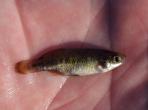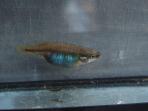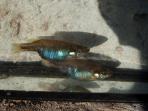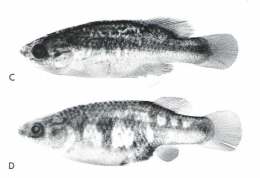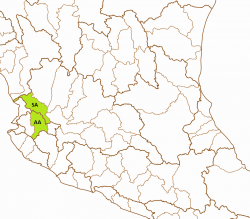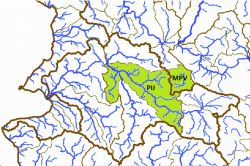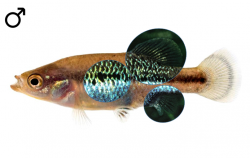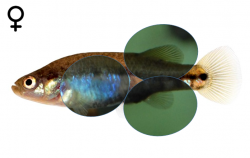- HOME
- WHO WE ARE
- NEWS AND DATES
- GOODEIDS
- PHYLOGENY
- ARTIFICIAL KEY
- GOODEID SPECIES
- BIOLOGY
- ENVIRONMENT
- CONSERVATION
- PROFUNDULIDS
- MEMBERS AREA
Allotoca maculata
English Name:
Blackspot Allotoca
Mexican Name:
Tiro manchado
Original Description:
SMITH, M. L. & R. R. MILLER (1980): Allotoca maculata, a new Species of Goodeid Fish from Western México, with comments on Allotoca dugesi. Copeia 3: pp 408-417
Holotype:
Collection-number: University of Michigan Museum and Zoology, Cat. No. UMMZ-200250.
The Holotype is a mature male of 27.2mm standard length, collected by R. R. Miller & J. M. Fitzsimons on February the 2nd, 1970. This specimen was kept alive until December 24th of the same year. Another 48 specimens of lengths between 10 and 37mm (Cat. No. UMMZ-178322), 51 specimens 10 to 48mm long (Cat. No. UMMZ-203851) and another two pairs (Cat. No. UMMZ-219779) were added from the type location to the description. All of them were obtained or reared in Ann Arbor and not preserved directly after the sampling.
The following pictures compare the Holotype and a gravid female Paratopotype of Allotoca maculata (left) with a pair of Allotoca dugesii (right) with the male above:
Terra typica:
The Holotype was collected in the Laguna Magdalena, Jalisco, about 82km W of Guadalajara at the Highway 15. Paratypes of the description (15 specimens) were collected at the Hacienda San Sebastián, about 2km N of Etzatlán.
Etymology:
The species name is derived from the Latin word "macula" which means "spot". The adjective "maculata" has therefore the meaning "spotted" in reference to the typical black basicaudal spot of this species.
The genus Allotoca was erected by Hubbs and Turner, published by Turner in 1937 and taken from the manuscript of the famous monography about Goodeids that Hubbs & Turner finally published together in 1939. Though the authors mentioned the posterior insertion of the dorsal fin, "the more fundamental characters of Allotoca, however, are ovarian and trophotenial..." The word ἄλλος (állos) means different and τόκος (tókos) offspring, so the genus refers to the different looking trophotaenia of the fry with the generic name meaning "different offspring".
Synonyms:
none
Distribution and ESU's:
The Blackspot Allotoca is endemic to the Mexican federal state of Jalisco. Its historical known distribution range is restricted to the endorheic Laguna Magdalena basin including several irrigation channels, the spring at the Hacienda San Sebastián draining to the Arroyo Chacuaco, and the Laguna El Palo Verde, like the Arroyo Chacuaco connected with the Laguna Magdalena via an artificial channel. It was also known from the Canal del Bajío (Río San Marcos), 6km W of the Palo Verde lagoon and 1.8km E of the town of San Marcos, an affluent of the Arroyo El Zapatero, that finally coalesces as Arroyo Chiquito with the Río Ameca past Amatlán de Cañas about 25km beeline W of San Marcos, so therefore this creek belongs to the Río Ameca drainage. The species hasn't been found in the Río Ameca system since 2000, at the Hacienda San Sebastián for decades and it became scarce in the Laguna Magdalena. Last succesful samplings concentrate on channels close to the Magdalena lagoon, on the Laguna El Palo Verde and a connected pond close by. There is one old report of Allotoca dugesii or maculata from the E-coast of the Laguna San Marcos in Jalisco, about 12km W of the Chapala lake and recent rumors about an Allotoca maculata/dugesii type fish from the Laguna de Sayula drainage near Atoyac, but these records need to be verified (likely a misidentification with "Xenotoca" cf. melanosoma). Two subpopulations, the Laguna Magdalena subpopulation (type subpopulation) and the Río San Marcos subpopulation can be distinguished. This second subpopulation might go back to a quite recent stream capture. The bold names are the ones officially used by the Instituto Nacional de Estadística y Geografía; nevertheless, other ones might be more often in use or better known and therefore prefered.
ESU ist short for Evolutionarily Significant Unit. Each unit expresses an isolated population with different genetic characteristics within one species. ESU's can be defined by Molecular genetics, Morphology and/or Zoogeography and help in indicating different phylogenetic lineages within a species. The abbreviation for an ESU is composed of the first 3 letters of the genus, followed by the first 2 letters of the species name and an ongoing number in each species.
We actually distinguish two ESU's in Allotoca maculata: Altma1 for fish from the endorheic Laguna Magdalena basin and Altma2 for those from the Arroyo Chiquito drainage. The second one was thought to be a spearate species, but this was obviously a mistake (pers. com. Omar Domínguez).
The left map shows the Río Santiago-Aguamilpa basin (SA) from the Hydrographic Region Lerma-Santiago and the Río Ameca-Atenguillo (AA) basin from the Hydrographic Region Ameca on a Mexico map. The Blackspot Allotoca is known from the Laguna Magdalena-Laguna Palo Verde subbasin (MPV), Río Santiago-Aguamilpa basin, and from the Río Ameca-Pijinto subbasin (PIJ), Río Ameca-Atenguillo basin, where it is probably extinct now. The right map shows these confirmed subbasins, while rumoured collection sites outside of these drainages haven't been verified so far and are therefore not considered. Altma1 occurs in the Laguna Magdalena-Laguna Palo Verde subbasin, Altma2 in the Río Ameca-Pijinto subbasin:
Status :
International Union for Conservation of Nature (IUCN): Critically Endangered
Distribution and current conservation status of the Mexican Goodeidae (Lyons et al., 2019): Critically Endangered/declining: „This species was described from the endorheic Lake Magdalena basin in west-central Mexico, where it was thought to be endemic (Smith and Miller, 1980). Believed extinct by the late 1980s (Miller et al., 1989), this species was rediscovered in the 1990s at two locations, Lake Magdalena and the nearby but hydrologically isolated headwaters of the San Marcos River in the Ameca River basin near the town of Etzatlán. Genetic analyses indicated that the San Marcos populations represented at least a distinct ESU and possibly an undescribed species (Doadrio and Domínguez-Domínguez 2004). We recognize two ESUs. Altma1, the Lake Magdalena ESU, is critically endangered and in decline from water pollution, habitat destruction, and non-native species. It has not been collected in more than four years despite several targeted surveys; and Altma2, the San Marcos ESU, is also critically endangered and in decline from water scarcity, habitat destruction, and non-native species, persisting in small numbers at one or two locations.“
NOM-059-SEMARNAT-2010: no categoría de riesgo (no category of risk)
Habitat:
Following Miller (2005), the Blackspot Allotoca inhabits shallow lake margins and ciénegas in clear to muddy water over easily roiled, soft-mud substrates. It prefers depths of less than 0.5m. In the dry season it survives well in the very shallow, well-vegetated water of shrinking lentic habitats. The vegetation may be sparse to absent, but water hyacinths have been dense at the type locality when collections were made in 1957 and 1970. Some Hydrocotyle were also present. The late afternoon water temperature on 27. February 1957 and 22. February 1970 were 15.5 and 16.2°C, respectively. In the late 1990, some new habitats of this species were discovered like the El Palo Verde lagoon and ditches and pools around San Marcos. The lagoon has an extension of 1.3 x 0.8km and is partly covered with Eichhornia crassipes. The Blackspot Allotoca was hiding in the dense roots of this plants or between flooded grass. The ditches and pools near San Marcos dry mostly up over the summer and as a result of pollution and invading fish species (Pseudoxiphophorus bimaculatus), no Goodeids were found in these habitats since 2015.
GWG surveys of the habitats of Allotoca maculata revealed this species in 2016 opposite the Laguna Palo Verde in a private pond. This artificial pond was filled with murky water, shaded with only little riparian vegetation underneath the Allotoca were hiding. In this year, the group was not successful to find this species in the Laguna Palo Verde itself as it was densely covered with Eichhornia and barely accessible. In October 2018 again, another survey of the northern bank of the lagoon was sucessful in finding several individuals, among them almost all females were gravid. The species was hiding in the roots of water lilies and close to the bank in the riparian vegetation.
Biology:
Robert R. Miller collected pregnant females in late (22. and 27.) February 1970 being and young individuals about 10mm long. A survey of the GWG of the Laguna Palo Verde in October 2018 found almost all collected females highly gravid, expecting a birth within the coming two weeks
Diet:
Conical teeth with those in the outer row enlarged (like in all Allotoca) and a short gut indicate carnivorous feeding habits.
Size:
The maximum known standard length is 48mm (Miller et al., 2005).
Colouration:
Adults are light grey-green dorsally and silvery below. The colour of the backs of females extends onto the sides in three to six vertical bars separated by four to seven prominent blotches of light iridescent blue. These dark vertical or obliquely directed bars are weak and diffuse anteriorly, most prominent above vent and anal fin and typically number only one posterior to the base of the anal fin. Females have one or more irregular dark spots situated on the caudal peduncle. Males have a lateral series of fine dark spots beginning behind the opercle and becoming denser posteriorly with the spots usually coalescing to form a diffuse lateral stripe on the caudal peduncle that ends in a dense spot the size of the pupil at the caudal base. Many males bear a dark lateral spot below or slightly in advance of the dorsal fin origin. Backs and sides of males are generally grey-green with flecks of iridescent blue showing through on lower sides, especially during the courtship. The preopercle and opercle in both sexes are metallic blue and the cornea is golden. The perianal region is often dusky, sometimes heavily so in females. The fins are mostly clear but with a dusky colour on the interradial membranes. The caudal fin may take on a light yellow colour in courting males.
Sexual Dimorphism:
Males and females of the Blackline Allotoca are easy to distinguish. A safe characteristic is the Splitfin in males, means the for Goodeinae typical mating organ formed by a notch after the first seven shortened rays of the Anal fin. Additionally, male Allotoca maculata have a bigger Dorsal fin than females. The difference in colouration is clear and very distinct. Males have a dark line separating a grey-greenish back from a light silvery-white belly. In females, the dark line separates the brown back from a striking bright blue belly with a few brown vertical bands on the caudal peduncle separating the blue there into a short serious of blue vertical bands. The belly itself stays usually free of vertical bands (though they are faintly noticeable) and the blue appears brighter during courthip and is probably used to attract males. Some females have the belly sometimes superimposed by black areas. Forms with black dots or blotches on the back are known, but these black markings are not gender-related. Black blotches in the middle of the body are species-specific. Females are a bit longer than males with a bigger and blunt head, but some experience is necessary to see these characters. Males appear a bit rectangular as a result of its bigger Anal and Dorsal fins.
Remarks:
In the years 1980 and 1982, during a long dry period, the Laguna Magdalena dried totally up and this species was not captured for many years (until 1990) and therefore reported extinct (Miller, 1990). Finally, M. L. Smith rediscovered it in an artificial pond near the dry bed of the lagoon. Lyons (2004) and a Czech group of hobbyists (2008) reported this species again from the lake respectively an outlet channel from the Magdalena lagoon. Pictures of the fish taken by the Czech group identified them as "Xenotoca" cf. melanosoma. However, there is still the chance this species can be found in the Laguna Magdalena.
As a reaction on the threats this species is facing, the Austrian Association of Aquarists (ÖVVÖ) started a Studbook on this and all other Allotoca species (including the closely related Neoophorus regalis).
In 1999 and 2000, the Dutch Hobbyist Brian Kabbes surveyed several of the newly discovered habitats around the endorheic Laguna Magdalena-basin and found Allotoca maculata widly distributed and sometimes in masses. Most of these habitats were small ditches, pools or small muddy lakes (for examples channels and ditches around San Marcos and Granja Sahuaripa), some of them well planted, others with open water-surface. Not even 20 years later, most of these habitats are gone and only the area around the Palo Verde lagoon seems to have quite good stocks of this species.
For a couple of years and as a result of early phylogenetic studies, these populations were thought to belong to an undescribed species (Allotoca sp. "Etzatlán"), but these results are seen as mistakes today and the populations are regarded as part of Allotoca maculata.
According to several scientists (Domínguez-Domínguez, Webb) this species is the most basal one in the genus Allotoca.
Husbandry:
Looking on the biotopes of Allotoca maculata, they suggest the species may prefer a habitat with moderate to none current, structured with gravel, rocks, roots, branches, fallen leaves and river bank vegetation. Fry is eaten in some cases, but it may depend on the quantity and quality of food and on the number of places to hide. When several different stages of juveniles occur, fry may be neglected, so it makes sense to add separate brought up fry to the group with a size of 1.5 or 2cm to provide these stages and get a flock breeding colony.
The recommended tank size is at least 100 liters, bigger tanks with a generous base and little height (25cm are enough) are better for sure. With rocks and vegetation in the corners and backsinde of the tank well structured tanks combined with some roots and/or wood seem to do best with this species. The current should be moderate, especially as the species is adapted to a high oxygene level (at least 8mg/l), despite of the stagnant waterbody it occurs in the wild.
In the wild, the species feeds mainly from small or middle-sized invertebrates like bloodworms or insect larvae, so feeding with similar food, water fleas, Mysids and other food from animalistic sources will be best for this predatory fish. In aquarium, it feeds also well from flake food, granulate and even tablets, additionally given Nauplia of Brine Shrimps are eaten greedy. The species is not really shy, but likes to use hiding spots to observe the surrounding.
Concerning water quality, this species is in need of bigger water changes (60-80% every week) like most of the Goodeids, so an automatic water changing system can be helpful. Otherwise, in combination with constant temperatures higher than 24°C, fish may get sick, lose resistance against diseases and age too fast. So for keeping the strain healthy and strong, give the fish a rest during winter time with temperatures lower than 20°C for 2 or 3 months so they stop producing fry. In contrary to many Allotoca species, that can be kept down to temperatures of 15 or 16°C without problems for months with some species even lower, this species likes it a bit warmer and requires a minimum temperature of 17°C in winter. In spring, when the temperature slowly increases, they will start spawning at 20 or 21°C and won't stop until it gets colder again or when it gets too warm (25°C).
This species is doing very well when is kept in the open from spring to fall, starting when the water temperature by day exceeds 17°C and cold periods are no longer expected. Bring them out in the early afternoon, the time of the day with the highest water temperature. During the warm summer, reproduction will stop and may occur again in fall. Bring the fish in before the water temperature deceeds 17°C by day and keep them cool for the first days, then slowly raise the temperature but try to stay below 20°C over the winter time.
Populations in holding:
Here each species are assigned populations of fish in husbandry and in brackets aliases of these locations to assist in identifying own stocks. Each population is assigned a unique Population-ID, composed by the ESU, the subbasin where this population is occurring (three capital letters) and a unique location identifier.
Populations in holding:
1. Altma2-MPV-PaVer
Population: Palo Verde
Hydrographic region: Lerma-Santiago
Basin: Río Santiago-Aguamilpa
Subbasin: Laguna Magdalena-Laguna Palo Verde
Locality: Palo Verde lagoon W of Etzatlán






